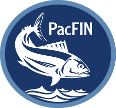About PacFIN
The Pacific Fisheries Information Network (PacFIN) is a collaboration between member state and federal fishery agencies that supply the information needed to effectively manage fish stocks on the west coast of the United States. The data is stored, processed and disseminated by members of PacFIN staff. The member agencies include the Californian Department of Fish & Wildlife, Oregon Department of Fish & Wildlife, Washington Department of Fish & Wildlife, National Oceanic and Atmospheric Administration (NOAA), Pacific States Marine Fisheries Commission (PSMFC), and Pacific Fisheries Management Council (PFMC).
PacFIN is one of 4 regional commercial Fishery Information Networks in the United States. Starting in 1974, the PSMFC worked with State and Federal agencies to improve data quality and timeliness for use in fisheries management. The establishment of marine fisheries councils by the Magnuson Fisheries Conservation and Management Act of 1976, stressed the necessity of comprehensive, high quality regional fisheries data to meet the fishery management council’s needs. To meet the needs of the PFMC, PacFIN was established by an interagency committee and the database became operational in 1981.
The member groups can roughly be divided into data suppliers and data users. The state agencies supply data on the amount of fish landed at authorized dealers through the fish ticket system. Fish tickets supply information on the trip and the seafood the dealer purchased. One complication is that dealers often purchase fish in categories driven by the market or ease of identifying the fish rather than by species. To address these sometimes imprecise grouping and to identify contamination within the categories the states implemented a port sampling program to subsample purchased fish to elucidate the true composition of the purchased fish and to identify their area of catch. The subsampled data is used to create species composition and area composition proportions which are calculated and applied at stratas supported by the data. State agencies also supply data on vessel registrations and more specific data on the activities of trawlers through the trawl logbook program.
Once data from each state is sent to PacFIN data are checked for errors and converted so that the data are all in the same format. For example, each state uses its own codes for gear and species. As part of the processing, PacFIN transforms these codes into standardized code. Data from various sources are also combined to create value added data. This includes adding vessel or permit information associated with a landing to the fish ticket data.
Federal Agencies and PFMC are generally data users, but do also supply some data such as at-sea catches and discards, fishing permits, etc. Stock assessors at NOAA use the value added data in combination with data such as logbooks to generate estimates of fish stocks and acceptable levels of fishing on those stocks. Data is also used to examine economic trends, check for rule compliance, regional and country wide summaries of fishing, and for many other analyses.
